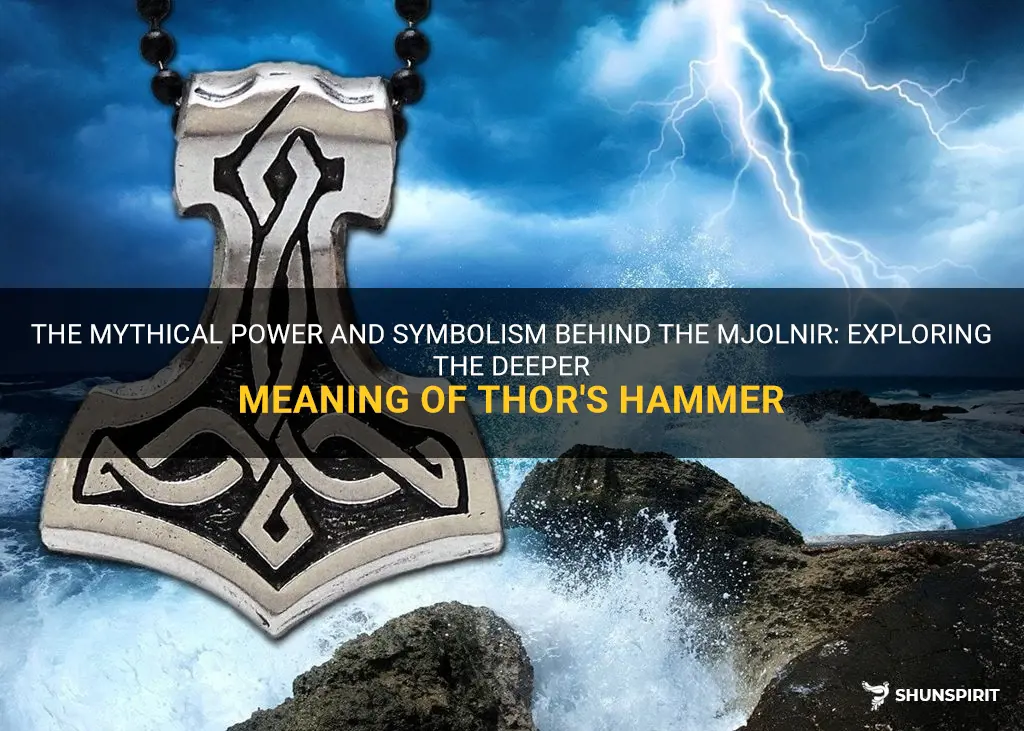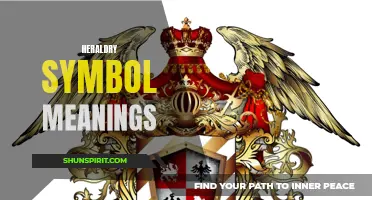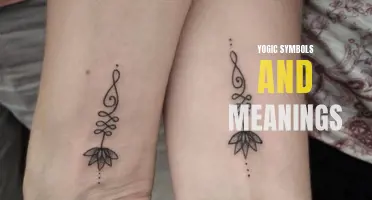
Mjolnir, the hammer of the mighty Thor, is not just a weapon or a tool but a symbol of power, strength, and protection. This iconic Norse artifact holds deep cultural and spiritual significance, embodying the gods' righteousness and ability to vanquish evil. From its origins in ancient Norse mythology to its present-day representation in popular culture, the mjolnir symbol exudes an aura of might and reverence, resonating with those who seek courage and hope in the face of adversity. Join me as we explore the rich symbolism behind this legendary hammer and delve into the enduring legacy it has carved throughout history.
What You'll Learn
- What is the significance of the Mjolnir symbol in Norse mythology?
- How did the Mjolnir symbol come to represent Thor and his power?
- Are there any variations in the meaning of the Mjolnir symbol across different Norse cultures?
- How is the Mjolnir symbol interpreted and used in modern Norse pagan and Heathen practices?
- Can the Mjolnir symbol also be seen as a symbol of protection and strength in non-Norse contexts?

What is the significance of the Mjolnir symbol in Norse mythology?
The Mjolnir symbol holds great significance in Norse mythology. Also known as Thor's hammer, Mjolnir is one of the most iconic and important symbols in the Norse pantheon. It is associated with Thor, the god of thunder and lightning, and is seen as a representation of his power, strength, and protection.
Mjolnir is a unique and powerful weapon, forged by the dwarves Brokkr and Sindri. It is said to be unbreakable and has the ability to return to Thor's hand after being thrown. The hammer is also known for its ability to control the weather, causing thunderstorms and lightning strikes. It is the main weapon that Thor uses to defend Asgard against the giants and other enemies.
The symbolism of Mjolnir goes beyond its physical characteristics. It represents the power of Thor and his role as a protector of the gods and mankind. It is a symbol of strength, courage, and honor. Thor wields Mjolnir with great determination and fearlessness, making it a symbol of bravery and warriorship.
Mjolnir also holds a protective function. It is believed to be able to defend the gods and mortals against evil forces and prevent harm from coming their way. It is often used in rituals and ceremonies to invoke Thor's protection and blessings. It is a symbol of safety and security, providing a sense of comfort and reassurance to those who wear or carry it.
The Mjolnir symbol is widely recognized and used as an emblem of Norse paganism and modern Asatru or Heathenry. It is commonly worn as a pendant or charm to honor the gods and express one's connection to Norse mythology. It is seen as a mark of identity and allegiance to the old Norse traditions.
In recent years, the Mjolnir symbol has gained popularity beyond the realms of mythology and religion. It is now a well-known symbol in popular culture, particularly due to its association with the Marvel Comics superhero Thor. The Thor movies and comics have brought the symbol into mainstream consciousness, making it recognizable to a wider audience.
In conclusion, the significance of the Mjolnir symbol in Norse mythology is immense. It represents the power, protection, and strength of Thor, the god of thunder. It symbolizes bravery, warriorship, and honor, as well as providing a sense of safety and security. The symbol has become a widely recognized emblem of Norse paganism and is now popular in popular culture.
The Mysterious Symbolism of Lilith: Unraveling the Meanings Behind an Ancient Figure
You may want to see also

How did the Mjolnir symbol come to represent Thor and his power?
The Mjolnir symbol is widely recognized as the representation of Thor, the Norse god of thunder and strength. This powerful symbol has roots in ancient Norse mythology and has become synonymous with the character of Thor and his immense power. In this article, we will explore the origins of the Mjolnir symbol and its significance in Thor's mythos.
Mjolnir, also known as Thor's Hammer, is a legendary weapon in Norse mythology. According to the mythology, the hammer was crafted by the dwarves Brokkr and Sindri, who were known for their exceptional craftsmanship. The god Loki, acting out of mischief, attempted to hinder their progress by turning into a fly and repeatedly biting Brokkr's eyelid. Despite this interference, the two dwarves managed to complete the hammer, creating a weapon of incredible power.
Mjolnir was not just a weapon; it also possessed a variety of other magical properties. It had the ability to control lightning and thunder, summon storms, and even revive the dead. The hammer, when thrown, always returned to Thor's hand after hitting its target, making it virtually unstoppable.
The symbol itself, known as the Mjolnir symbol, is widely recognized as the shape of Thor's hammer. It consists of a short handle with two elongated, symmetrical wings on either side. The wings are often depicted as curved, resembling the shape of a bird's wings in flight.
The Mjolnir symbol has come to represent not only Thor but also his power and authority as the god of thunder. It is frequently used as an emblem of strength, protection, and the ability to overcome obstacles. The symbol is often worn as jewelry, tattooed on the skin, or used in various forms of art and decoration.
The association between Thor and Mjolnir has been popularized in various forms of media, particularly in Marvel Comics and the Marvel Cinematic Universe. In these adaptations, Thor wields Mjolnir as his primary weapon, harnessing its immense power to protect the realms from threats. As a result, the Mjolnir symbol has become a recognizable emblem of the character and is often used as a representation of Thor in any form of media.
In conclusion, the Mjolnir symbol came to represent Thor and his power through its origins in Norse mythology and its depiction in various forms of media. Its association with the god of thunder and strength has made it a powerful and recognizable symbol that represents Thor's might and authority. Whether seen in ancient Norse texts or modern-day adaptations, the Mjolnir symbol continues to be an enduring representation of Thor and his legendary power.
Understanding the Symbolic Meaning of the Coqui Taino Symbol
You may want to see also

Are there any variations in the meaning of the Mjolnir symbol across different Norse cultures?
The Mjolnir symbol, also known as Thor's hammer, is one of the most iconic symbols in Norse mythology. It represents the mighty weapon wielded by the god Thor and is often associated with strength, protection, and divine blessings. While the general meaning of the Mjolnir symbol remains consistent across different Norse cultures, there are variations in its interpretation and usage.
In Norse mythology, the Mjolnir symbol is often depicted as a hammer with a short handle and a large rectangular head. It is said to have been created by the dwarves Brokkr and Sindri, who imbued it with various magical properties, including the ability to return to Thor's hand after being thrown. As the symbol of Thor's power, Mjolnir is often used to invoke the god's protection and strength in times of need.
However, there are slight variations in the meaning and representation of the Mjolnir symbol across different Norse cultures. In some regions, Mjolnir is seen as a symbol of fertility and abundance, representing the ability to bring forth new life and blessings. This interpretation is often associated with the agricultural aspects of Norse culture, where a bountiful harvest was highly valued.
In other Norse cultures, the Mjolnir symbol is associated with the Viking warrior tradition. It is seen as a symbol of courage, bravery, and victory, representing the strength and power needed to overcome one's enemies. This interpretation is often linked to the Viking belief in Valhalla, where fallen warriors were said to be welcomed by the god Odin and honored for their deeds in battle.
Furthermore, the Mjolnir symbol can also be perceived as a symbol of protection and warding off evil. It is often worn as an amulet or pendant to ward off malevolent spirits and bring good luck. This interpretation is particularly prominent in Norse paganism and modern Nordic neopaganism, where the Mjolnir symbol is seen as a talisman of divine protection.
While these variations exist, it is important to note that the Mjolnir symbol's core meaning of strength, protection, and divine blessings remains consistent across different Norse cultures. Whether it is seen as a symbol of fertility, warrior prowess, or spiritual protection, the Mjolnir symbol represents the power of Thor and embodies the qualities associated with the god. Its significance and usage may differ slightly, but its essence as a symbol of strength and divine favor remains unchanged.
In conclusion, the Mjolnir symbol is a powerful and widely recognized symbol in Norse mythology. While there are variations in its interpretation and usage across different Norse cultures, its core meaning of strength, protection, and divine blessings remains consistent. Whether it is seen as a symbol of fertility, warrior prowess, or spiritual protection, the Mjolnir symbol encapsulates the power and qualities associated with the god Thor.
Exploring the Symbolic Chart: Decoding the Meaning of Evil Eye Colors
You may want to see also

How is the Mjolnir symbol interpreted and used in modern Norse pagan and Heathen practices?
The Mjolnir symbol, also known as Thor's hammer, holds a significant place in Norse pagan and Heathen practices. It is a powerful symbol associated with the god Thor and has both historical and mythological importance. In modern times, the Mjolnir symbol has become popular among those who follow Norse spirituality, and its interpretation and usage vary among different individuals and groups.
The Mjolnir symbol is often seen as a representation of protection, strength, and thunder. It is believed to have the power to ward off malevolent spirits and protect its wearer. As such, it is common for individuals to wear Mjolnir pendants or incorporate it into their tattoos as a means of invoking Thor's protection and strength. Some also view the symbol as a representation of fertility and invoke it to seek blessings for their families and homes.
In addition to its protective qualities, the Mjolnir symbol is associated with Thor's ability to control lightning and thunder. It is seen as a symbol of power and authority, especially in matters of justice. Some Heathens and Norse pagans may use the Mjolnir symbol in ritual practices to invoke Thor's strength and ask for guidance or assistance in matters requiring justice or resolving conflicts.
The interpretation of the Mjolnir symbol also extends to its usage in rituals and ceremonies. It is often included as an altar decoration or used as a focal point during prayers and invocations. Some practitioners might hold Mjolnir-themed rituals or blóts (sacrificial ceremonies) to honor Thor and seek his blessings.
However, it is important to note that the interpretations and usage of the Mjolnir symbol can vary significantly among individuals and groups. Some may view it as a sacred symbol only to be used in specific religious contexts, while others might see it as a representation of their cultural identity or heritage. For many, the Mjolnir symbol holds personal significance and is used as a way to connect with Norse spirituality and honor their ancestors.
It is also worth mentioning that the modern usage of the Mjolnir symbol has faced controversies, primarily due to its associations with white supremacists and extremist groups. These groups have co-opted the symbol, leading to misconceptions and negative perceptions. However, it is crucial to distinguish between these extremist associations and the authentic usage of the symbol within the context of Norse paganism and Heathenry, which promotes inclusivity, respect, and honoring ancient traditions.
In conclusion, the Mjolnir symbol plays a significant role in modern Norse pagan and Heathen practices. Its interpretation and usage vary among individuals and groups, with many viewing it as a symbol of protection, strength, and justice. Whether as a sacred representation or a cultural identifier, the Mjolnir symbol holds personal significance and serves as a connection to Norse spirituality and ancestral traditions. It is essential to understand the authentic usage of the symbol, separate from its associations with extremist ideologies, as it continues to be embraced by those who seek a deeper connection to their Norse roots.
10 Symbols That Represent New Beginnings
You may want to see also

Can the Mjolnir symbol also be seen as a symbol of protection and strength in non-Norse contexts?
The Mjolnir, also known as Thor's hammer, is a symbol deeply ingrained in Norse mythology. It is commonly associated with the Norse god of thunder, Thor, and is depicted as a powerful weapon capable of causing lightning and thunder. However, the Mjolnir symbol holds significance beyond its Norse origins and can be seen as a symbol of protection and strength in non-Norse contexts as well.
Throughout history, the Mjolnir symbol has been adopted by various cultures and belief systems as a symbol of protection. It is seen as a talisman that invokes the protective powers of Thor and offers strength to its wearer or possessor. This interpretation transcends cultural boundaries and can be observed in different parts of the world.
One such example is the adoption of the Mjolnir symbol by some branches of neopaganism and contemporary Viking revival movements. In these contexts, the Mjolnir symbol is often seen as a representation of strength, protection, and even defiance against adversity. It serves as a reminder of the virtues associated with Thor, such as courage and honor, and is believed to provide its bearer with similar qualities.
In addition to its religious and spiritual associations, the Mjolnir symbol has also found its way into popular culture, particularly in the realm of comic books and superhero stories. The character Thor, wielding Mjolnir, has become an iconic symbol of strength and protection in the Marvel Universe. The hammer is depicted as a literal and figurative source of power, emphasizing its role as a protective symbol.
Furthermore, the Mjolnir symbol has been embraced by certain communities as a representation of personal strength and resilience. People may choose to wear Mjolnir pendants or incorporate the symbol into their tattoos as a reminder of their own inner power. It becomes a symbol of their ability to overcome obstacles and protect themselves from harm.
Overall, while the Mjolnir symbol originates from Norse mythology, its interpretation as a symbol of protection and strength extends beyond its initial context. Whether as a religious talisman, a superhero emblem, or a personal symbol of resilience, the Mjolnir represents the enduring human desire for protection and the strength to face challenges. It is a symbol that connects individuals across cultures and beliefs, reminding us of our innate capacity for strength and protection.
The Spiritual Significance and Symbolism of Diamonds: Unlocking Their Hidden Meanings
You may want to see also
Frequently asked questions
The Mjolnir symbol, also known as Thor's Hammer, holds great significance in Norse mythology. It represents the power and protection of the thunder god Thor. As the most powerful weapon in Norse mythology, Mjolnir is said to be able to create lightning, thunder, and stormy weather. It symbolizes strength, courage, and the ability to overcome obstacles.
Wearing a Mjolnir pendant symbolizes a connection to Norse mythology and the values associated with it. It can represent a person's strength and protection, acting as a talisman or amulet to ward off negative energies or evil forces. It can also be seen as a symbol of one's belief in Norse gods and the heritage and traditions that come with it.
The Mjolnir symbol can be worn by anyone, regardless of their cultural or ethnic background. While it may have originated in Norse mythology, it has become a popular symbol in contemporary culture and is often worn by individuals who resonate with its meanings of strength, protection, and connection to ancient traditions. It serves as a reminder of personal power and inner strength, regardless of one's ancestry.
Yes, there are various interpretations and variations of the Mjolnir symbol. While the basic design typically includes a hammer shape with a handle, details such as the size, design elements, and embellishments may differ. Some versions may incorporate additional symbols or inscriptions, such as runes or knotwork, which further enhance its symbolism and meaning.
While the Mjolnir symbol is associated with Norse mythology, wearing it does not necessarily indicate adherence to any specific religious belief. It can be seen as a cultural or personal symbol rather than a strictly religious one. However, for those who follow modern Norse or Heathen traditions, wearing the Mjolnir symbol can be an expression of their religious and spiritual beliefs, as well as a way to honor and connect with the gods and ancient Norse practices.







